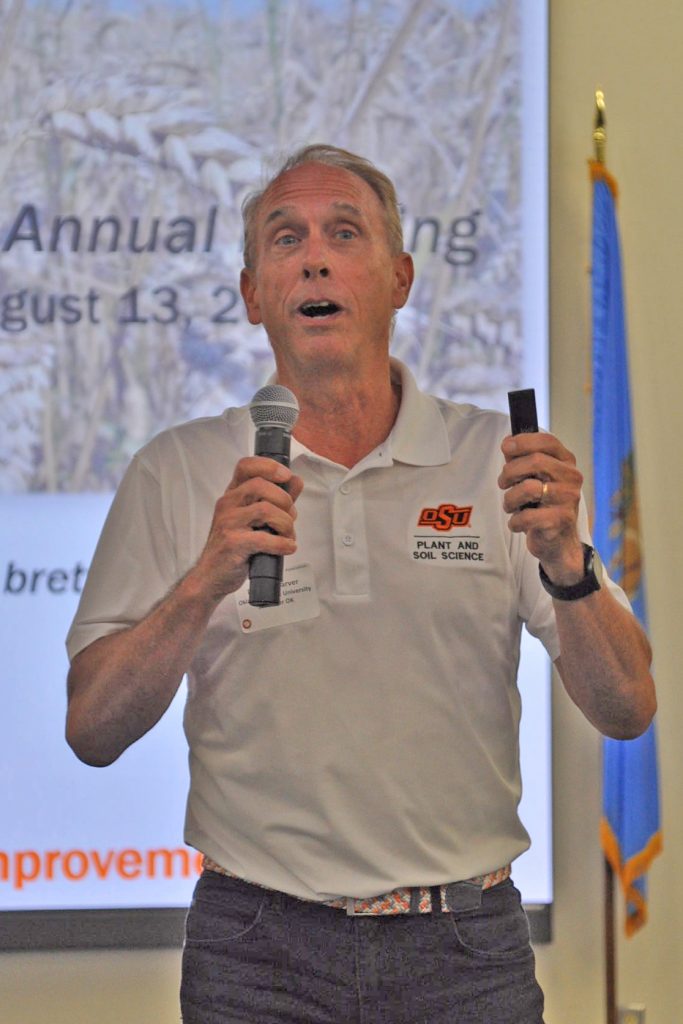Oklahoma State University is out with a new variety that offers unrivaled scab resistance and plans to release within the year a higher yielding version of Doublestop, the most widely planted variety in the state, according to OSU’s chief wheat geneticist Brett Carver.
Carver appeared at several producer meetings, including serving as keynote speaker at the Oklahoma Wheat Growers Association annual meeting in Enid, where he gave a recap of research results from the past year and discussed future plans for the breeding program.

OSU Scab Stryker, released in March, is intended for areas of the state where wheat is planted directly into corn residue. Corn harbors a fungal disease that can be triggered in wheat heads when moisture conditions are right.
“It’s not like stripe rust, where it blows in from Mexico. It’s got to originate on some kind of plant tissue we have out in the field,” Carver said.
The new variety is still susceptible to stripe and leaf rust, which are more common. But it’s cheaper and easier to control those diseases than to treat scab, which requires precise timing and a more expensive fungicide, Carver explained.
OSU’s first foray into scab resistance is as robust as anything on the market. Kansas State University also offers some good options, including Everest and Zenda.
OSU and K-State are currently collaborating on the next generation of scab resistance, which promises to deliver even better protection in the future, Carver said.
Future releases
Also nearing release is an experimental line that represents the next generation of Doublestop. It performed at the top of this year’s statewide trials, along with High Cotton, Showdown and Paradox.
Doublestop was first released in 2013 and currently makes up around 10 percent of all Oklahoma wheat acreage planted to known varieties.
While it’s already a dependable dual-purpose wheat with high protein potential and built-in herbicide tolerance, the new and improved version will boost yields, Carver said.
The big story disease-wise in 2024 was stripe rust, which invades Oklahoma fields roughly three years out of 10.
On that score, Smith’s Gold, one of the state’s four most planted varieties, came through with flying colors.
Carver is testing a derivative of Smith’s Gold, made up of 50% Romanian germplasm, which could eventually serve as a replacement.
“Smith’s Gold has great stripe rust resistance and grazes well, but I would like to get the yield potential up. I think this might be the one to do that,” he said.
Over the past decade, resistance to leaf and stem rust has improved overall, Carver noted, which gives new varieties more longevity.
Another vexing problem in the southern Plains is grassy weed control. To help provide more options, OSU is getting ready to launch the program’s first herbicide tolerant wheat bred to fit the CoAxium system, originally developed at Colorado State University as an alternative to Clearfield technology.
Certification of herbicide tolerance requires eight separate trials over two years, and OSU is now entering the second year of that process, Carver said.
“We need to thin the troops and get it down to one candidate from six. We were at 33, so we’re going in the right direction,” he said.
Grazing calculations
The past year’s data corroborated Carver’s suspicion that genetic selection is leading to varieties that can be grazed longer without a negative effect on grain yield.
“We need to make sure we don’t pull cattle off before we have to. I think this year we pulled cattle a little too early on average,” he said.
Doublestop and Unchartered could have been grazed a week or more longer, he noted, while Strad had yield losses of up to 45% after being grazed too long.
The common threshold for removing cattle is first hollow stem, which refers to the stage of growth when the open stem between the crown of the root and the developing grain head reaches the same length as the diameter of a dime.
OSU Extension provides fact sheets and videos on how to take the measurement. The Oklahoma Mesonet provides a mapping tool that shows progression of maturity across the state, broken out by variety.
The map relies on data provided by the OSU Extension Service. But those measurements are typically taken on wheat planted in mid-September without being grazed or continuously clipped, Carver said. Nine times out of 10 that wheat will break dormancy earlier than grazed or clipped wheat that was planted at the same time, he said.
“We need to think about a better approximation of hollow-stem arrival time relative to the actual crop that’s out there being grazed,” Carver said.
He recommended growers scout their fields carefully in the spring and make pull-off decisions based on their own observations, noting maturity rates can vary by as much as three weeks.
OSU leads the nation in the development of dual-purpose wheat and guidelines for how to manage it, a feature that garners interest beyond the state’s borders.
In Texas, for example, OSU varieties are now planted on a quarter of the state’s wheat acreage.
“I tell my customers they can do multiple things with OSU varieties, and they are really impressed by that,” said Kevin Igo, a diversfied farmer and seed supplier based in the Texas panhandle at Plainview.
Just as notably, OSU varieties were among the top three highest yielding in every Texas trial where they were tested last year.
Carver said selecting for grazing tolerance makes for better adapted plants overall, with greater ability to recover from late freezes, drought and disease or pest infestations.
He also said nutrient management strongly influences how varieties perform, with later fertilization offering some advantages.
Last year, fields in which the total applied nitrogen was split between planting and mid-winter had dramatically less stripe rust in the canopy.
“There is a price to pay for applying all the nitrogen up-front,” he observed. “Wait until January, even if the plants don’t look that good early on.”
Upward and onward
This year’s Oklahoma wheat harvest exceeded expectations, coming in at 105.3 million bushels, based on an average yield of 39 bushels harvested from 2.7 million acres, up 54% from the previous year.
That beat an early industry forecast of 98.8 million bushels, made a month before harvest.

Brodie Bush, of Alva, who is entering his second year as a seed dealer, said it was good to return to historical averages following two years of drought.
While producers were slow to book seed early on, he expected the pace to pick up going into the fall.
Originally a cattle producer, he saw an opportunity to enter the wheat seed business in 2023.
“When I started farming, I would go and pick up seed from dealers, and I always found it an interesting process, just the science behind it. I decided maybe that was something I was interested in. So I started my own dealership,” he said.
“There’s a need right now for young seed dealers who are willing to step up and take this on,” he added. “I’ve enjoyed it. It’s a new adventure. It’s been good to us.”
Interest in OSU varieties is at an all-time high, and he’s impressed with the new genetics on the horizon.
Since 2000, OSU has released 36 varieties and recently launched a campaign to fund a new Agronomy Discovery Center, which will include 12 state-of-the-art research greenhouses, labs and classroom space.
“Lots of great varieties are coming out right now, and producers are excited about it,” Bush said. “Our biggest issue is weather. But it’s a little difficult to order the right amount of rain at just the right time.”
Candace Krebs is with Oklahoma Genetics Inc.



